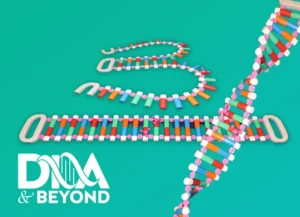In addition to these permanent building blocks, DNA also has a tiny partner who interacts with the helix only for certain tasks. This partner is the methyl tag. Its main function is to act as the on/off-switch for a gene. When a pair of methyls are attached to a gene sequence, they turn the gene off, putting it down for a “genetic nap.” When they are removed by a special cellular machine, the gene is switched back on and ready to be read and used. Methyl tags play an important role in human health–for example, when a cancer-fighting gene is erroneously switched off.
In DNA, methyl tags always connect to cytosine (C). This combination is referred to as “methylated cytosine” or “the fifth letter in the DNA language”. Our model provides little magenta-colored tags shaped like a Mickey Mouse head with three ears; we designed them that way with their chemical structure in mind. These methyl (– CH 3 ) groups consist of a carbon atom (the big “head”) and three hydrogen atoms (the smaller “ears”). In the model, they plug into the holes you will find in two of the crimson parts near the middle of the DNA- string. The methyl tag is just one of a whole family of chemical tags, which are lurking just above DNA itself. Some of these attach to the tiny spools upon which the DNA helix is wound up for storage, and the tags can either “lock up the DNA” (as if the DNA was placed in a locked drawer), or alternatively, these tags can unlock the DNA and open up access to read its coded information.
The existence and function of these tags has only come to light in the past few decades, and research about them is accelerating. This super-hot new area of biology has a name: epigenetics (“epi”, from the Greek, meaning “above”). See “Digging Deeper” for more information.


